Morris & Fan. Reservoir Sedimentation Handbook
Подождите немного. Документ загружается.

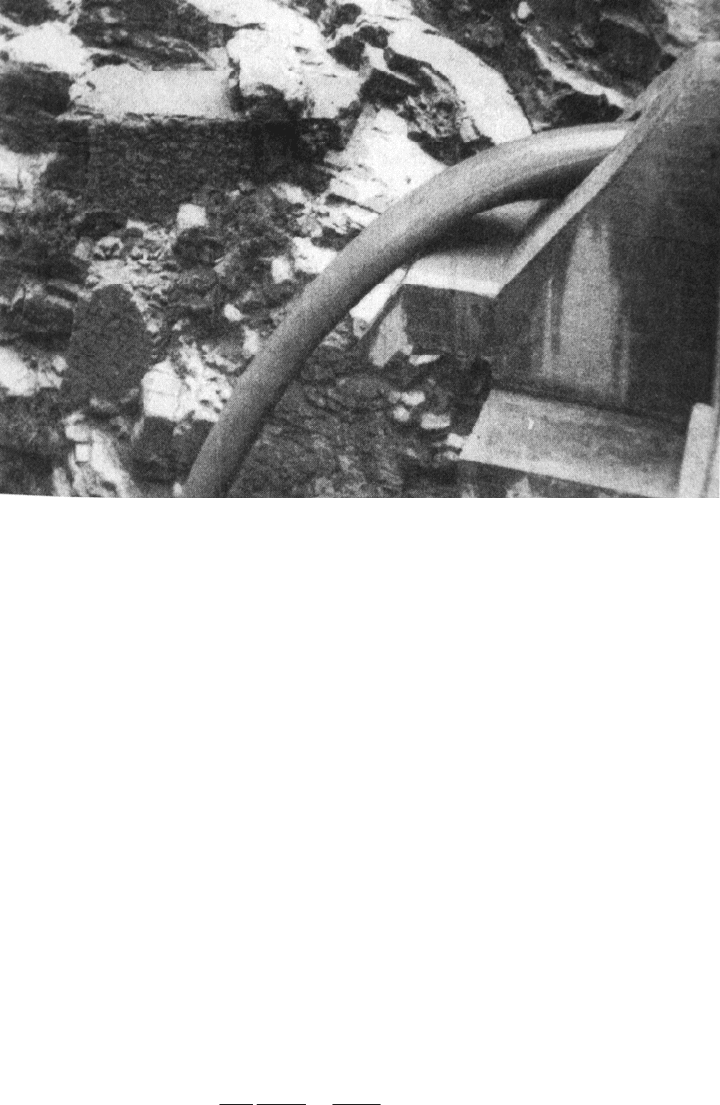
TURBID DENSITY CURRENTS 14.21
FIGURE 14.16 Photograph of turbid water from the muddy lake being discharged from the
low-level outlet at Steeg Reservoir, Oued Fodda, Algeria.
14.7.5 Height of Aspiration
When a turbidity current reaches a dam and is vented, water will be aspired from levels
both above and below the outlet level. There is the potential to entrain clear water from
the layer above the turbidity current, releasing clear water when it is not necessary.
Similarly, when an intake is operated at a level above a muddy lake, it is possible to
entrain turbid water from the muddy lake. A definition sketch illustrating these
phenomena is shown in Fig. 14.17, and symbols are defined below.
Q total discharge through orifice, m
3
/s
q discharge per unit width of slotted outlet, m
3
/s
h
L
height of aspiration, m, as in definition sketch
g gravitational constant = 9.8 m/s
2
F
2
two-dimensional densimetric Froude number for slot aspiration
F
3
three-dimensional densimetric Froude number for orifice aspiration
The limiting height of aspiration is the point at which clear or turbid water first starts to
be released or aspired through the outlet.
A theoretical analysis of the limiting height of aspiration H
L
of a density current was
made by Craya (1946), resulting in the following expression:
34.0
8
27
22
3
q
gh
L
(14.3)
Experiments to determine the limiting height of aspiration were conducted using slots or
orifices in laboratory flumes. A slot produces a two-dimensional flow field, and an
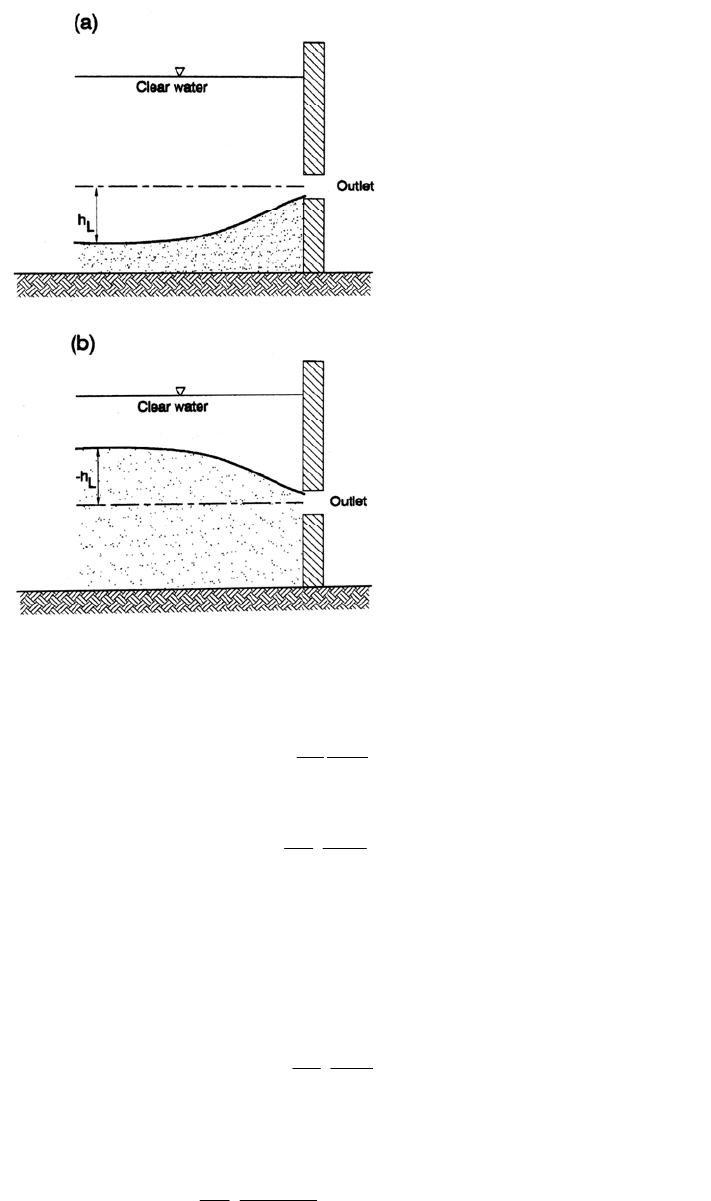
TURBID DENSITY CURRENTS 14.22
FIGURE 14.17 Definition sketch
showing interface configuration
at the limiting condition for: (a)
aspiration of turbid water from
muddy lake through a low-level
outlet, and (b) aspiration of clear
water when venting a turbidity
current.
ori
fice produces a three-dimensional flow field. Based on experiments with saline
water, Gariel (1946, 1949) obtained the relationship for the limiting height of aspiration
for a slot:
gh
L
3
q
2
0.43
(14.4)
The following equation was obtained for an orifice:
154.0
2
5
Q
gh
L
(14.5)
Fan (1960) performed flume tests using turbidity currents and described the mixing pattern
in the vicinity of an orifice. Mixing with the overlying water can be violent because of the
existence of a vertical vortex at the outlet, which produces a second mixing zone extending
above the turbidity interface. The aspiration height was measured and expressed in
terms of the densimetric Froude number. For a slot, the limiting depth for aspiration of
turbid water from below the slot axis is given by:
75.0
3/1
2
3
2
q
gh
F
L
(14.6)
and the aspiration height at which clear water begins to be entrained from above the slot
is given by:
75.0
)(
3/1
2
5
2
q
hg
F
L
(by extrapolation) (14.7)

TURBID DENSITY CURRENTS 14.23
For an orifice, the limiting depth for aspiration of turbid water from below the axis is
8.0
5/1
2
5
3
Q
gh
F
L
(14.8)
and the aspiration height at which clear water begins to be entrained from above the
orifice axis is given by:
2.1
)(
5/1
2
5
3
Q
hg
F
L
(14.9)
During 1961 and 1962, turbidity currents were released from Sanmenxia Reservoir
through 12 gates, each 3 m wide and 8 m tall, located at an elevation of 300 m. The
original riverbed at the dam was 280 m, but because of sediment accumulation it rose
to about 290.5 to 292 m during 1961, and to 294 to 295 m during 1962. From these
tests, and with 304 m as the axis elevation, the following values of F
3
were determined
by using the orifice equations (14.8) and (14.9):
F
3
= 0.9 lower aspiration limit (h
L
) in 1961
F
3
=1.1 lower aspiration limit (h
L
) in 1962
F
3
= –0.4 clear-water aspiration limit (-h
L
) in both years
The data from Sanmenxia Reservoir may be used to estimate aspiration height (either h
L
or -h
L
) by rearranging Eq. (14.9) to solve for aspiration height for an orifice:
5/1
2
3
)/(
g
Q
Fh
L
(14.10)
The appropriate values of F
3
may then be substituted directly. The clear-water aspiration
height –h
L
, was significantly less than h
L
, possibly because of the large cross-sectional
area of the outlet gates and the shallow water depth before the dam. The flow pattern was
quite different from that simulated in the laboratory flume.
14.8 COMPUTATIONS
Density current computations are complicated by the unsteady nature of the flow
resulting from variable inflow and water levels and continuous deposition of sediment and
entrainment of clear water, which changes the density within the current. Reservoir
bathymetry is also nonuniform in the longitudinal direction, and will also gradually
change over time as a result of sediment accumulation. This section presents several
equations which may be used to make a preliminary evaluation of the potential for
turbidity currents to reach the dam.
14.8.1 Computational Strategy
Hand computations can be used to give a rough idea of the potential for turbidity currents
to reach the dam. To make a preliminary evaluation of whether turbid density currents
can transport material to the dam, the following procedure is recommended. Because
inflowing discharge varies with time, an "average" discharge value for the flood
duration should be used. Computations should be performed for the larger events which
transport significant amounts of sediment.
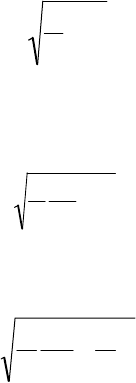
TURBID DENSITY CURRENTS 14.24
1. Compute the water depth at the plunge point [Eq. (14.2)] to provide the first
indicator of the potential for turbidity currents to occur, and to indicate the area
within a reservoir where a turbid density current can form as a function of the density
difference between the impounded and inflowing water, and the discharge.
2. Compute the velocity of the turbidity current based on the suspended solids
concentration of the inflow.
3. Based on the velocity, determine the maximum grain size that can be transported.
4. Remove all larger grains, then return to step 2 and recompute for the grains remaining
in suspension.
By performing the recomputation of steps 2, 3, and 4 through several iterations it will
become evident whether the current can be sustained with a significant sediment
concentration or will rapidly fade away.
It is important to recall that the computational procedure assumes a steady state at each
reiteration, and does not reflect the time required for the sediment to settle out. If the
travel time to the dam is short, and the settling velocity of the sediment within the current is
low, the current may transport a significant amount of material to the dam under
nonequilibrium conditions. If these preliminary computations suggest the potential for
significant turbidity transport to the dam, further analysis would be performed with field
measurements and numerical modeling.
14.8.2 Flow Velocity of a Turbid Density Current
The flow velocity of a density current can be determined in a manner similar to that for
open channel flow. In open-channel flow:
V
8
f
gRS (14.11)
where V = velocity, f = friction coefficient, R = hydraulic radius, and S = bed slope. In a
density current the gravitational acceleration should be modified to express the
gravitation force exerted by the density difference ∆ρ between the turbid water and the
stationary clear water, resulting in the following equation for density current velocity:
V
8
f
gRS
(14.12)
Assuming the depth is much less than the width, we can substitute depth of the density
current h for the hydraulic radius R. Assuming a rectangular density current cross section
with a width of B, we can substitute the continuity equation h = Q/BV to obtain:
3
8
S
B
Q
g
f
V
(14.13)
The friction coefficient f represents the total interfacial frictional effects including the
channel bed plus the boundary with the overlying stationary fluid. In Chinese reservoirs,
the friction value is typically in the vicinity of f = 0.025.
14.8.3 Grain Size That Can Be Transported
On the basis of field data, Fan (1986) presented the relationship shown in Fig. 14.18 for
roughly predicting the maximum grain diameter that can be transported by a turbid den-
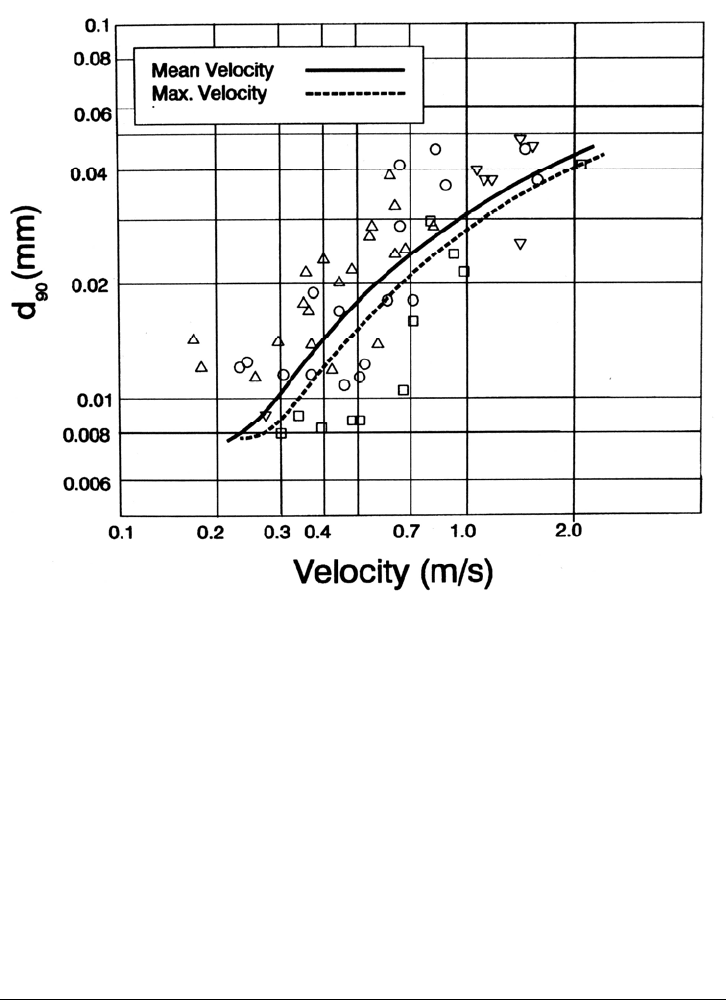
TURBID DENSITY CURRENTS 14.25
FIGURE 14.18 Relationship between turbidity current velocity and the grain size that can be
maintained in suspension (after Fan, 1986).
sity cu
rrent, as a function of forward velocity. In short reservoirs the slowly settling
sediment may not have the opportunity to settle out of the moving current, and larger
material may be transported to the dam than predicted because of delayed sedimentation.
Somewhat different conditions may also apply in reservoirs having different sediment
characteristics. For example, Tolouie (1993) reported that density currents in the large
Sefid-Rud Reservoir transported grain sizes larger than those reported in Chinese
reservoirs, as discussed in that case study (Chap. 23). At high concentrations,
sedimentation can be significantly retarded by hindered settling. The settling rate can also
be influenced by flocculation mechanisms within the turbid water.
14.9 MONITORING DENSITY CURRENT MOVEMENT
When it is desired to evaluate the potential to release turbid density currents from an
existing reservoir, detailed monitoring is recommended. Modern monitoring technology
allows accurate, cost-effective measurements to be obtained from automated
equipment. The typical monitoring arrangement would consist of an inflow station
immediately above the point where the stream enters the reservoir, plus one or more
stations along the length of the impoundment. If the pool is at a low level, previously
deposited sediment may be scoured from the bottom of the reservoir and the suspended solids
concentration at the plunge point may be significantly greater than measured at the inflow

TURBID DENSITY CURRENTS 14.26
station. This phenomenon should be considered when selecting monitoring stations and
interpreting data.
Submerged turbidimeters can be used to detect the arrival of the advancing current at
each lake station, thereby determining its forward velocity. Either a closely spaced array
of turbidimeters or dipping sondes may be used to determine the thickness of the current.
Because the inflowing current will drop the coarsest fraction of the load, and because
turbidimeters are highly sensitive to small grain sizes but not to coarser particles, water
from the current will need to be sampled if turbidity readings are to be used to estimate
suspended solids concentration. Samples collected from an existing outlet at the dam can
be used to determine the arrival time at the dam plus the grain size that is transported to the
dam. However, because of the potential problem of clear-water aspiration, if a high-
discharge outlet is used the suspended solids concentration in the outlet is not
necessarily indicative of the sediment concentration within the current.
The grain size transported by the current may also be determined from shallow
bottom cores or surface sediment samples immediately following a turbidity current
event. Cores that penetrate through the material deposited by several events may be
interpreted to determine the grain size that "normally" reaches the dam.
14.10 CLOSURE
Turbidity currents are of great importance in distributing sediment along the length of a
reservoir, and focusing sediment deposition within the deepest portion of each cross
section. In some cases turbidity currents can be used to release large volumes of sediment
from reservoirs. However, the behavior of turbid underflows in reservoirs is not easy to
quantify, and field measurement represents the best method to document their behav
CONCEPTS OF RESERVOIR LIMNOLOGY 4.27

CHAPTER 15
FLUSHING
15.1 CONCEPT AND APPLICATION
15.1.1 Overview
Hydraulic flushing involves reservoir drawdown and emptying by opening a low-level
outlet to temporarily establish riverine flow along the impounded reach, eroding a
channel through the deposits and flushing the eroded sediment through the outlet. Unlike
sediment routing, which attempts to prevent deposition during flood events, flushing uses
drawdown and emptying to scour and release sediment after it has been deposited.
However, sediment entering the reservoir during flushing periods will also be routed
through the impoundment and released.
There are two key features that distinguish flushing from sediment routing. Flushing
operations (1) remove previously deposited sediment and (2) the timewise pattern of
sediment release below the dam differs significantly from sediment inflow. The change in
the pattern of sediment release is greatest when flushing is conducted during the non-
flood season, as illustrated in Fig. 15.1. However, the sediment release pattern will also
differ from sediment inflow when flushing is conducted during a portion of the flood
season. A large volume of accumulated sediment will be released during a short period of
time, generating extremely high sediment concentrations. In contrast, sediment routing
largely maintains the natural seasonality of sediment transport along the river, as was
illustrated in Fig. 13.4
The channel scoured through the deposits is maintained by repeated flushing, usually
at annual intervals. In wide reservoirs the flushing channel will erode only a narrow
channel through the deposits, to produce a channel and floodplain-type geometry (Fig.
15.2). While sediment deposited in the channel each year can be eroded during the
subsequent flushing period, sediment deposited on the floodplains during impounding
periods will continuously accumulate. Auxiliary flushing channels may be used in addi-
tion to the main flushing channel to remove a portion of the floodplain sediment.
Generally, a large flushing discharge through low-level outlets is necessary to preserve
long-term storage capacity.
15.1.2 Classification of Techniques
Fan (1985) has classified flushing into two general categories: (1) empty or free flow
flushing, which involves emptying the reservoir to the level of the flushing outlet with
riverine flow through the impoundment, and (2) pressure flushing, which requires
less drawdown but is also less effective. The second method is not commonly used.
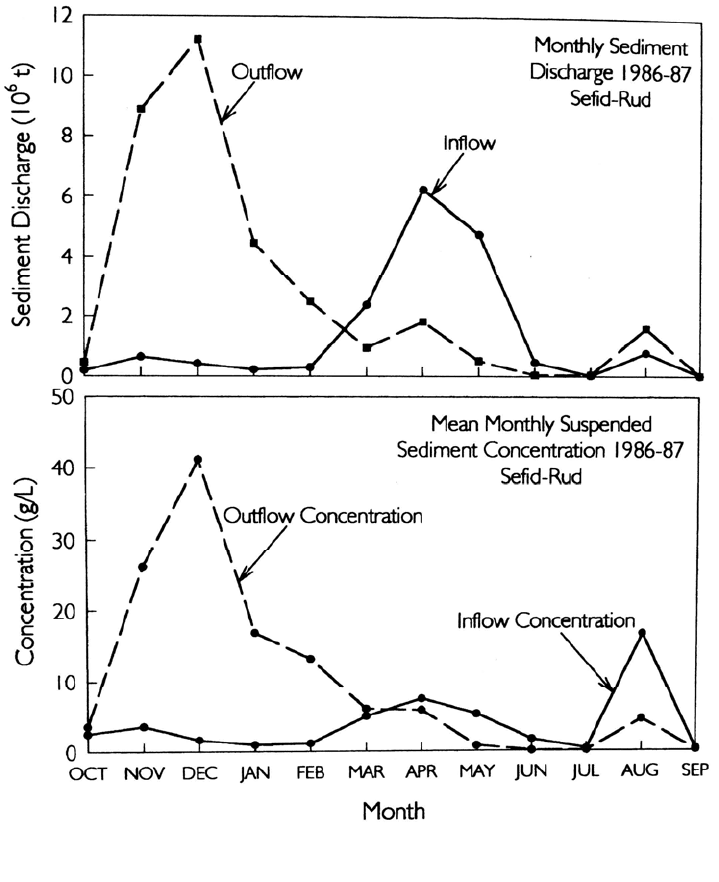
FLUSHING 15.2
FIGURE 15.1 Change in the seasonality of sediment delivery below Sefid-Rud Reservoir,
Iran, caused by flushing (data from Tolouie, 1993).
Empty flushing can also be classified according to whether it occurs during the flood
season or the nonflood season. While both strategies have been employed successfully,
flood season flushing is generally more effective because it provides larger discharges
with more erosive energy, and floodborne sediments may be routed through the
impoundment.
15.1.3 Applications
Flushing can be used to reduce or halt sediment accumulation and to recover reservoir
capacity, and has been successfully applied at numerous hydropower and irrigation
reservoirs which are drawn down for periods ranging from days to months. It has been
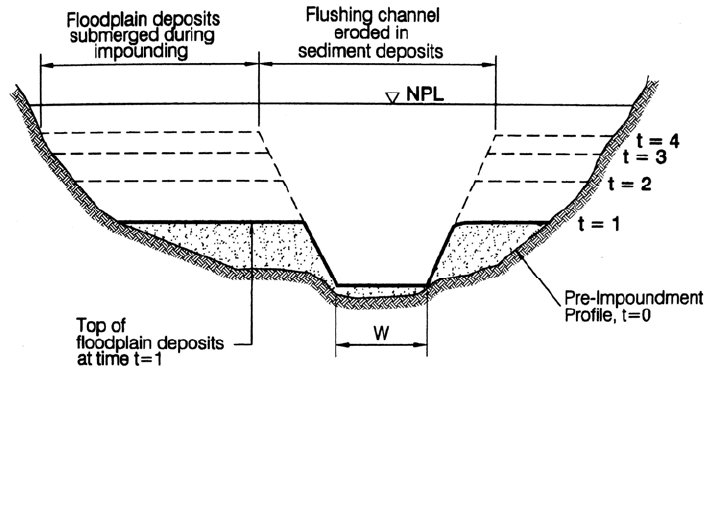
FLUSHING 15.3
successfully employed at reservoirs having a wide range of physical sizes but all having a
small hydrologic size [a capacity to inflow (C:I) ratio typically less than about 0.3],
allowing the reservoir to be refilled quickly when the bottom outlet is closed to terminate
flushing. It can also be used at hydrologically larger sites that have been reduced in size
by sediment accumulation. Sediment sizes removed by flushing have ranged from clay to
gravel. Details of flushing operations at the small Cachí and Gebidem hydropower
reservoirs and at the large Sefid-Rud irrigation reservoir are described in the their studies,
and the combination of sediment routing and flushing is described in the Sanmenxia and
the Heisonglin case studies.
FIGURE 15.2 Reservoir cross section showing development of flushing channel an
d
adjacent flood-plain deposits that are submerged during normal impounding. The floodplai
n
level will rise over time as deposition continues, but the rate of rise will decrease. In
a
narrow reservoir, the main channel may span the width of the impoundment and floodplains
may be absent.
15.1.4 Limitations
There are two main limitations to flushing. First, it is necessary to draw down or empty
the reservoir. This limits flushing to hydrologically small reservoirs without carryover
storage, that can be removed from service during the flushing period. Second, flushing
causes sediment to be released from the reservoir at a much higher concentration than
occurs in the natural fluvial system. The initial period of flushing, with a duration ranging
from a few hours to several days, depending on the size of the reservoir, is characterized
by extremely high sediment concentrations, typically exceeding 100 g/L at the dam site
and in some cases even exceeding 1000 g/L. These extreme concentrations can create
unacceptable impacts downstream. Extreme sediment concentrations can clog irrigation
canals and heat exchangers for industrial cooling systems, they are unsuited for
hydropower use, they can exceed the solids handling capacity of water purification
plants, and the combination of turbid water and muddy deposits severely impairs recre-
ational use. Environmental harm can be great; the combination of high sediment con-
centration (which smothers benthic organisms and clogs gills) and anoxia can kill
virtually all the organisms in a stream. Sediment deposits along the streambed may con-
tinue to affect the stream benthos long after the flushing has been completed and may
also impair navigation and increase flood hazard by reducing channel capacity. Sediment
ranging
from a few hours to several days, depending on the size of the reservoir, is characterized
by extremely high sediment concentrations, typically exceeding 100 g/L at the dam site
and in some cases even exceeding 1000 g/L. These extreme concentrations can create
unacceptable impacts downstream. Extreme sediment concentrations can clog irrigation
canals and heat exchangers for industrial cooling systems, they are unsuited for
hydropower use, they can exceed the solids handling capacity of water purification
plants, and the combination of turbid water and muddy deposits severely impairs recre-
ational use. Environmental harm can be great; the combination of high sediment con-
centration (which smothers benthic organisms and clogs gills) and anoxia can kill
virtually all the organisms in a stream. Sediment deposits along the streambed may con-
tinue to affect the stream benthos long after the flushing has been completed and may
also impair navigation and increase flood hazard by reducing channel capacity. Sediment
